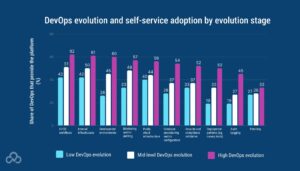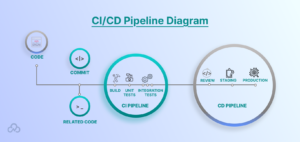Introduction
Nowadays, companies need to provide software fast and with few issues because it has become essential. Many now expect their digital experiences to be smooth, which forces businesses to keep up with quick changes in the market. Agile and advanced development methods require processes that are quicker and less dependent on handing over code between teams. It is at this stage that DevOps, synced with CI/CD, makes a significant difference.
DevOps CI/CD helps make workflows more efficient by bringing together the development and operations teams. Thanks to automation, partnership, and ongoing feedback, DevOps helps teams release applications more swiftly, detect errors early, and improve the apps’ stability. With CI/CD, everything from writing and testing new code to deploying it is fully automated. This accelerates delivery while still keeping the code high quality. This article discusses how using DevOps CI/CD services can change the way you develop software by allowing you to automate parts of your process. Something else it explains is how by using cloud-native offerings such as DevOps as a Service, teams can avoid dealing with infrastructure matters and instead focus on coming up with new ideas. CI/CD forms the backbone of improving and speeding up the way software is deployed, no matter the scenario.
Understanding DevOps and CI/CD: A Foundation for Modern Software Delivery
What is DevOps?
DevOps brings the development (Dev) and operations (Ops) teams together to work on tasks from planning through to developing, testing, releasing, and monitoring software. It aims to make development faster, deploy software solution more often, and produce reliable software.
What is CI/CD?
CI stands for Continuous Integration, and CD stands for Continuous Deployment (or Delivery). A common DevOps approach is to automate and smooth the process of combining code changes, carrying out tests, and deploying the software. Every code change in this process is handled automatically by the CI/CD pipeline, reducing the amount of work needed by people.
CI (Continuous Integration): Programmers typically add their code to a single repository, setting in motion automated construction and testing routines. This allows you to detect changes in your code early, ensuring there are fewer problems while combining code.
CD (Continuous Deployment/Delivery): After CI completes, the changes are deployed to production or else the changes are staged for deployment right away (Continuous Deployment or Continuous Delivery). By doing this, organizations can get their code to end users faster.
Benefits of Automating DevOps with CI/CD Services

1. Faster Time-to-Market: Using automation eradicates delays in the development cycle. They are able to get new features and bug fixes into use faster and more often.
2. Higher Code Quality: Only code that passes all tests and validation is allowed into production.
3. Improved Collaboration: When everyone uses the same CI/CD pipelines, development, QA, and operations teams become more accountable.
4. Reduced Human Error: Automating reduces the risk of having an error while deploying and configuring software
5. Enhanced Scalability: With DevOps as a service, teams can grow both their systems and development methods when they need them, making it perfect for both smaller startups and larger companies.
The CI/CD Pipeline: Core to DevOps Automation
CI/CD pipelines make it possible for DevOps teams to carry out the steps in software development in an automatic and efficient way. All the pipelines I’ve studied, regardless of design, have a similar layout.
Typical CI/CD Pipeline Stages:
1. Source Stage: The code is stored in a Git version control system for later access. This triggers the CI/CD pipeline.
2. Build Stage: The source code is turned into programs that can be ran. Here, developers often rely on Maven, Gradle, or npm to help with dependency management and automating the build process.
3. Test Stage: Unit, integration, and UI tests are run to verify the build. If any tests do not pass, the pipeline will stop.
4. Artifact Storage: If everything goes well in the tests, the build artifacts are then moved to a repository (for example, JFrog Artifactory or AWS S3).
5. Deployment Stage: Workloads are sent to either staging, QA, or production by making use of Kubernetes, Docker, or serverless functions.
6. Monitoring & Feedback: Software like Prometheus, Grafana, or New Relic is used after rolling out code to track performance and give helpful information to developers.
CI/CD Pipeline Diagram

To visualize this, a pipeline diagram usually shows the steps in a straight line, and has areas for testing and manual checks that split off as needed, just like in a continuous delivery process. It starts with someone making changes to the code, then running some automatic building and testing processes, and finally putting those changes into either a test or live website. Each step is shown on the screen and is usually marked by arrows, little icons, or different colors that help show if things like builds are working, if tests are failing, or when it’s ready to deploy.
Including this visual representation in documentation or CI/CD dashboards makes it easier for teams to see what’s happening at each stage of the pipeline and spot any slow-downs or steps that didn’t work as planned. It helps the team work together by making it clear where the new version of the software is, which parts are done automatically, and which things still need someone to take care of them. This transparency is particularly helpful in fast-moving DevOps work, where getting quick feedback and being able to track changes is really important for keeping up with regular, good-quality releases.
Moreover, a clear pipeline diagrams makes it easier for new developers and DevOps engineers to get up to speed quickly by helping them understand how each step of the process fits together. It shortens the learning curve by showing how the CI/CD process works using pictures, so team members can easily see how code goes from being added in to the system all the way through to the final step of being deployed. As pipelines get more complicated, the diagram also becomes a useful guide for making things run faster and working out how to manage more automation.
DevOps as a Service: Outsourcing Efficiency
For many organizations, set-up and managing their own internal DevOps system can be quite expensive and a bit complicated. DevOps as a Service (DaaS) is a cloud-based option where other companies handle things like your continuous integration and delivery setup, the infrastructure, automation, and keeping an eye on everything for you.
Key Benefits of DevOps as a Service
– Cost-Effective: Cut down on the costs of maintaining and operating the infrastructure.
– Faster Onboarding: Standardized pipeline systems help new developers get working with a project right away.
– Expert Management: Have seasoned DevOps experts handle updating, scaling, and ensuring security in your system.
– Toolchain Integration: Brings together different tools such as Jenkins, GitLab CI/CD, CircleCI, Azure DevOps across the SDLC.
Choosing the Right CI/CD Tools and Services
Choosing the best CI/CD tools depends on your team size, tech stack, cloud strategy, and desired automation level. Here’s a breakdown of popular options across categories.
|
Tool |
Function |
Strengths |
|
Jenkins |
CI/CD Server |
Open-source, highly customizable, large plugin ecosystem |
|
GitLab CI/CD |
GitOps + CI/CD |
Fully integrated with Git repositories |
|
CircleCI |
CI/CD |
Fast builds, Docker support, scalable |
|
GitHub Actions |
CI/CD |
Native integration with GitHub repositories |
|
Azure DevOps |
DevOps Suite |
End-to-end toolchain, great for Microsoft ecosystem |
|
AWS CodePipeline |
CI/CD |
Tight integration with AWS cloud services |
Before selecting a tool, consider your needs for security, scalability, compliance, and ease of use.
Best Practices for Implementing DevOps CI/CD
1. Start Small, Scale Fast: Get started by focusing on one app or service and increase use of CI/CD as you become more confident.
2. Implement Version Control for Everything: Besides code, keep IaC, configuration settings, and documentation in version control as well.
3. Automate Testing: Prioritize unit and integration tests. Parallel testing can shorten the time the pipeline takes to complete.
4. Embrace Infrastructure as Code (IaC): Management of your infrastructure can be simplified with tools such as Terraform or CloudFormation.
5. Ensure Continuous Monitoring: CI/CD doesn’t end at deployment. Keep an eye on customer feedback to improve the following updates.
6. Incorporate Security Early (DevSecOps): Add tools to the early stages of development that can uncover issues in code, containers, and dependencies before things go to production.
Real-World Example: CI/CD in Action
Let’s take a look at a typical use case where CI/CD accelerates software delivery.
Scenario:
The fintech beginner continuously works on and updates its payment processing API. Before, it would take many hours to deploy, and it usually meant bugs would be introduced. Manual testing held up the release of new products and brought down the level of customer satisfaction.
Solution:
They set up GitLab CI/CD with Docker and Kubernetes for handling the containers. With automated pipelines:
– Code passes through automatic testing and also gets containerized.
– There are several stages in the process of deployment that happen many times a day.
– Updates to the production environment are done securely with the help of blue-green deployment.
Results:
– Deployment time reduced by 70%
– Errors in production decreased by 50%
– Increased customer satisfaction because the service updates actually show up when they say they will.
The Future of DevOps CI/CD
As DevOps matures, CI/CD tools will start to act more independently and intelligently. Soon, testing will rely on AI, deployment will be predictive, and infrastructure will fix itself. Another trend is GitOps, which is like CI/CD but with Git turning into the main source for both application and infrastructure.
New tools, such as Kubernetes Operators and serverless CI/CD pipelines, plus canary deployments and feature flags, can all help reduce the difficulty of software development.
FAQs
1. What is the difference between CI and CD in a DevOps CI/CD pipeline?
With CI (Continuous Integration), the code is integrated and tested in a common repository various times every day. Continuous Delivery/Deployment takes it another level, by either automating preparation of builds for manual release or automatically deploying to the production environment.
2. How does DevOps as a Service help accelerate software delivery?
DevOps as a Service (DaaS) automates development and deployment by handling the necessary infrastructure and tools in the cloud by a trusted provider. It allows dev teams to avoid creating and managing in-house pipelines, so they can code and innovate, with security and scaling taken care of by professionals.
3. Why is a pipeline diagram important in CI/CD workflows?
Using a pipeline diagram makes it easy for teams to monitor and fix issues in their CI/CD processes, as they can tell at a glance which stage is affected. As a result, team visibility is increased, teamwork happens more smoothly, and onboarding new staff is facilitated.
4. What are the key benefits of automating DevOps with CI/CD services?
Thanks to CI/CD automation, fewer mistakes can occur, the deployment process becomes more efficient, testing begins earlier, and it supports teamwork. It makes it possible to deliver software more quickly, receive regular feedback, and handle a growing demand for software.
Conclusion
Simply using CI/CD to speed up DevOps can lead to great things—automation, trustworthy performance, and regular progress. Adopting an organized CI/CD process, selecting the right solutions for your needs, and using DevOps as a Service bring better outcomes to a company’s software delivery.
Using DevOps CI/CD automation lowers the time it takes to introduce products, makes them higher quality, and brings more happiness to everyone by reducing stress. Modernizing your software delivery process and following DevOps practices should be your priority now, regardless of your type of business.
Do you like to read more educational content? Read our blogs at Cloudastra Technologies or contact us for business enquiry at Cloudastra Contact Us.